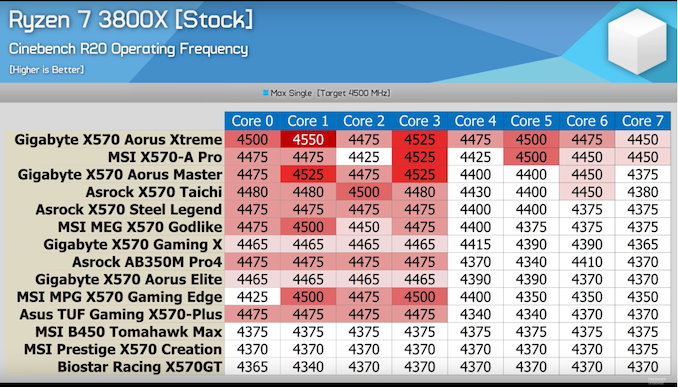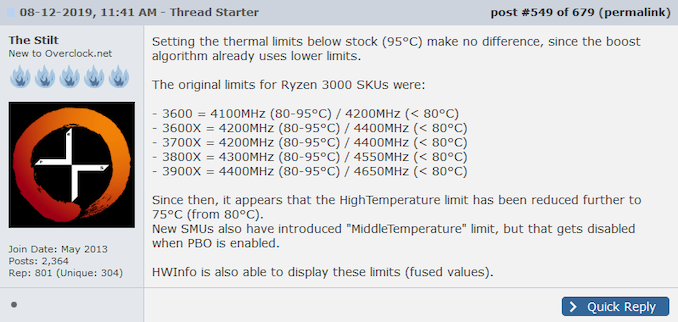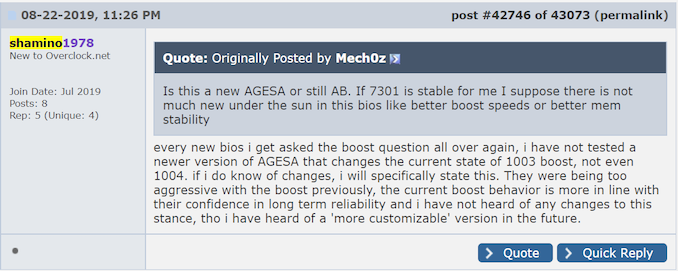Reaching for Turbo: Aligning Perception with AMD’s Frequency Metrics
by Dr. Ian Cutress on September 17, 2019 10:00 AM ESTAMD’s Turbo Issue (Abridged)
So why all this talk about how each company does its Turbo functionality, as well as its binning strategy? I prepped this story with the differences because a lot of our user base still thinks in terms of Intel’s way of doing things. Now that AMD is in the game and carving its own path, it’s important to understand AMD’s strategy in the context of the products coming out.
With that in mind, let’s cover AMD’s recent news.
Ever since the launch of Zen 2 and the Ryzen 3000 series CPUs, AMD has done its usual of advertising core counts, base frequency, TDP, and turbo frequencies. What has occurred since initial launch day reviews and through the public availability has been that groups of enthusiast users, looking to get the most out of their new shiny hardware, have reported that their processors are not hitting the turbo frequencies.
If a processor had a guaranteed 4.4 GHz turbo frequency, users were complaining that their peak turbo frequencies observed were 25-100 MHz less, or in some cases more than 100 MHz down on what was advertised. This kind of drop in frequency was being roughly reported through the ecosystem, but no-one particularly acted on it until these past few weeks, around the same time that AMD had several other news stories going on.
Multiple outlets, such as Hardware Unboxed, noted that the frequencies they were seeing significantly depended on the motherboard used. Hardware Unboxed tested 14 different AMD AM4 motherboards (some X570, others not X570) with a Ryzen 7 3800X, expecting a peak turbo frequency during Cinebench R20 of 4.5 GHz. Only one motherboard was consistent across most CPUs, while a few others were hit and miss.
This obviously plays into some reasoning that the turbo is motherboard dependent, all else being equal. It should be noted that there’s no guarantee that all these motherboards, despite being on the latest BIOSes, actually had AMD’s latest firmware versions in place.
Another outlet, Gamers Nexus, also observed that they could guarantee a CPU would hit its rated turbo speeds when the system was under some form of cold, either chilled water or a sub-zero cooling environment. This ultimately would lead some believe that this relates to a thermal capacity issue within the motherboard, CPU, or power delivery.
The Stilt, a popular user commonly associated with AMD’s hardware and its foibles, posted on 8/12 that AMD had reduced its peak temperature value for the Ryzen 3000 CPUs, and had introduced a middle temperature value to help guide the turbo. These values would be part of the SMU, or System Management Unit, that helps control turbo functionality.
Peter Tan, aka Shamino, a world renowned (retired) overclocker and senior engineer for ASUS’ motherboard division, acknowledged the issue in a forum post on 8/22 with his own take on the matter. He stated that AMD’s initial outlay with its turbo boost behavior was ultimately too aggressive, and in order to ensure longevity of the chip, the boost behavior was in line with what AMD needed to achieve that longevity.
It should be stated here that Shamino is speaking here in his personal capacity.
For those not engrained in the minutae of forum life, the biggest arrow to this issue came from Roman Hartung, or Der8auer, through his YouTube channel. He enlisted the help of his audience to tabulate what frequencies users were getting.
In the survey, the following details were requested:
- CPU
- Motherboard
- AGESA version/BIOS version
- PBO disabled
- Air cooling
Now obviously when it was announced that this survey was going to happen, Roman and AMD discussed behind the scenes the pros and cons about this survey. As you might expect, AMD had some reservations that this survey was in any way going to be fair – it’s about as unscientific as you can get. Naturally Roman argued that these would be real world results with users machines, rather than in-lab results, and AMD should be guaranteeing users on their home machines with specific frequency values. AMD also pointed out that with this sort of survey, you have an inherent selection bias: users who feel negatively impacted by any issue (through AMD’s fault or the users own) are more likely to respond than those that were happy with the performance. Roman agreed that this would be a concern, but still highlighted the fact that users shouldn’t be having these issues in the first place. AMD also mentioned that the Windows version couldn’t be controlled, to which Roman argued that if turbo is only valid for a certain Windows version, then it’s not fair to promote it, however did concede that the best performance was the latest version of Windows 10, and users on Windows 7 will have to accept some level of reduced performance.
Roman and AMD did at least agree on a testing scenario in order to standardize the reporting. Based on AMD’s recommendations, Roman requested from his audience that they use CineBench R15 as a single threaded load, and HWiNFO as the reporting tool, set to a 500 millisecond (0.5 second) polling interval, with the peak frequency from the CPU listed.
The survey ended up with ~3300 valid submissions, which Roman checked one-by-one to make sure all the data was present, screenshots showed the right values, and removed any data points that didn’t pass the testing conditions (such as PBO enabled). The results are explained in Roman’s video and the video is well worth a look. I’ve summarized the data for each CPU here.
| Der8auer's Ryzen Turbo Survey Results | |||||
| AnandTech | 3600 | 3600X | 3700X | 3800X | 3900X |
| Rated Turbo MHz of CPU | 4200 | 4400 | 4400 | 4500 | 4600 |
| Average Survey MHz | 4158 | 4320 | 4345 | 4450 | 4475 |
| Mode Survey MHz* | 4200 | 4350 | 4375 | 4475 | 4525 |
| Total Results Submitted | 568 | 190 | 1087 | 159 | 722 |
| # Results Minus Outliers | 542 | 180 | 1036 | 150 | 685 |
| Results >= Rated Turbo | 210 | 17 | 153 | 39 | 38 |
| % Results >= Rated Turbo | 50% | 9% | 15% | 26% | 6% |
| *Mode = most frequent result | |||||
I have corrected a couple of Roman’s calculations based on the video data, but they were minor changes.
For each CPU, we have the listed turbo frequency, the average turbo frequency from the survey, and the modal CPU frequency (i.e. the most frequently reported frequency). Beyond this, the number of users that reported a frequency equal to the turbo frequency or higher is listed as a percentage.
On the positive, the modal reported CPU frequency for almost all chips (except the 3900X) is relatively close, showing that most users are within 25-50 MHz of the advertised peak turbo frequency. The downside is that the actual number of users achieving the rated turbo is quite low. Aside from the Ryzen 5 3600, which is 50%, all the other CPUs struggle to see rated turbo speeds on the box.
As you might imagine, this data caused quite a stir in the community, and a number of vocal users who had invested hard earned money into their systems were agonizingly frustrated that they were not seeing the numbers that the box promised.
Before covering AMD’s response, I want to discuss frequency monitoring tools, turbo times, and the inherent issues with the Observer Effect. There’s also the issue of how long does turbo need to be active for it to count (or even register in software).













144 Comments
View All Comments
peevee - Friday, September 20, 2019 - link
Sunny Cove is about just as new as Zen2 compared to Zen+, if not more.Only not "architecture" but "microarchitecture", architecture is the same Von Neumann prevalent since 1940s, or its Harvard variant prevalent since 1980s.
Jovec - Tuesday, September 17, 2019 - link
Might go to credibility and past behavior. Bulldozer couldn't maintain stock speeds under load (although the lawsuit was for something else IIRC).evilspoons - Tuesday, September 17, 2019 - link
Thanks for the informative article. The modal frequency being so close to the rating on all those 3000-series chips, BEFORE the +25-50 MHz fix, means it's not even worth worrying about. As consumers it's good to be informed and keep an eye on the companies we buy from, but there's no conspiracy here. Just confusion.Karmena - Wednesday, September 18, 2019 - link
Companies have to be held accountable on what they write on the boxes. Even if that is off by 25 out of 4400. Just be honest and write 4375.Atari2600 - Wednesday, September 18, 2019 - link
I'm sure your bright enough to be able to round up to 1 decimal place.What does 4.375 become when rounded to 1 decimal place?
ianisiam - Wednesday, September 18, 2019 - link
Except for the fact that 4400 isn't guaranteed. Like evilspoons said, it's just confusion.eva02langley - Wednesday, September 18, 2019 - link
You didn`t read the article obviously... these are not guaranteed. If you apply thermal paste and HSF pressure like an amateur, your results will not be in line with AMD numbers, but of course you will scream rip-off...Karmena - Monday, September 23, 2019 - link
Will not scream, just it would be nice to have every little bit. With ABBA, that is the case, in the end I need good mobo, good cooling, some memory OC prooves and I do not have to worry about CPU OC as that is brought to maximum performance by itself already.limitedaccess - Tuesday, September 17, 2019 - link
I feel there is one more aspect to this that wasn't fully addressed nor have seen it very addressed in discussions.According to your article (which matches previous understanding) is that Intel (even if they won't guarantee it the boost speeds) will bin CPUs so that every core is capable of running at the listed turbo speeds. In your example every core can reach 4.6ghz for the 9600k.
While AMD with Zen is only binning one core as capable of reaching the boost speeds. Although you list a more likely typical example in your article does this not in theory mean that a 3600x which can only reach 4.4ghz on a single core, while all other 7 can only hit 3.8ghz will pass (even if statistically such a CPU is extremely unlikely)? Or is their binning actually tighter then this but not disclosed anywhere?
This has been one of my concerns with respect the this type of situation going forward. It seems like there needs to be more disclosure/data points on binning requirements going forward.
ajlueke - Tuesday, September 17, 2019 - link
Thanks Ian!Could you highlight what the nebulous "limits of the silicon" are? I have noticed, that in low current (core) work loads with Zen 2, the performance seems to be fixed. I'm not reaching any temperature, EDC, TDC or PPT boundary, but changing the scalar, increasing fmax, or increasing the aforementioned limits. It seems something else is limiting the processor's ability to boost, but there is no clear indication what that is. I have observed the Stilt mention the Fitness Monitoring Tool (FIT) as a voltage limit baked into the silicon. Zen 2, tend to be at this limit, and it simply will not go higher regardless of what you set PPT, TDC and EDC at. Do you have any additional information on this limiter?
It does seem fundamentally different for overclockers. The voltage limit on boosting seems to be reached before thermal limits, meaning that Zen2 CPUs with the stock cooler boost the same as those with far better heat dissipation, at least in lightly threaded workloads. I guess this is a good thing for users overall, as everyone gets the same performance out of the box, but jarring for enthusiasts who are used to seeing much high numbers on their systems. I noticed the delta between the bottom 5th percentile and upper 95th percentile of the 3900X on userbenchmark was 12.4%. Incredibly tight, and demonstrates that there likely isn't much to ring out of these systems.